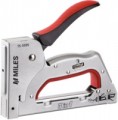Spring
The main structural element of the construction stapler. The spring first compresses, accumulating mechanical energy, and then decompresses, releasing it to clog the fastener. According to the type of springs are divided into two subcategories:
— Vitaya. The impact mechanism with a twisted (torsion) spring is cocked and then released when the lever is pressed. The force with which the bracket will be clogged is regulated using a special screw, if it is provided for in the design. The working resource of a twisted spring averages 10-12K strokes, after which the recoil becomes stronger and it is no longer so comfortable to work with the tool.
— Plate. In staplers with a leaf spring, a flat spring located horizontally is responsible for the tension of the striker. Usually, this type of springs is used in professional tools — they have a long service life (about 55 – 60K strokes), which allows the use of construction staplers for large-scale work.
Compatible staples
Staple models that the tool is compatible with.
Usually, quite specific options are indicated in this paragraph, so finding compatible consumables is not difficult. The specific dimensions of the fasteners should be specified according to the manufacturer's data — different brands use different markings.
Min. staple width
The smallest staple width that the stapler can handle.
The width of the bracket is, roughly speaking, the distance between its legs. Different situations and types of work require different sizes of staples, sometimes quite small. At the same time, staples that are too small will hang out in the store and will not be able to properly fit under the drummer, which is why modern staplers have a minimum size limit. You should pay special attention to it if you plan to work with brackets of small width.
Max. staple width
The largest width of staples (see Fastener Type) that the stapler can work with.
The width of the bracket is, roughly speaking, the distance between its legs. Different situations and types of work require different sizes of staples, and sometimes the width must be quite large. However, a staple that is too large simply will not fit into the store, not to mention the fact that the stapler can “shoot” it normally. Therefore, this limit cannot be exceeded, and if you plan to work with brackets, you should pay special attention to the maximum width when choosing.
Min. nail length
The shortest length of nails (see Fastener Type) that the stapler can handle.
The shorter the fastener, with the same thickness, the less effort is required to drive it, but a nail that is too short simply cannot stand under impact normally. Therefore, for many instruments, this restriction is directly indicated. It is worth paying attention to it first of all if you plan to work with small short nails.

